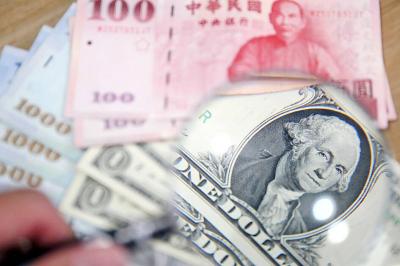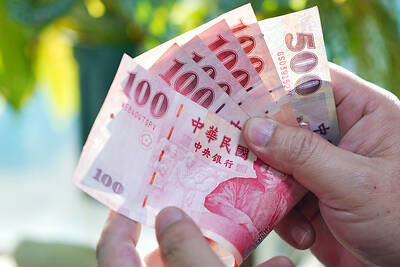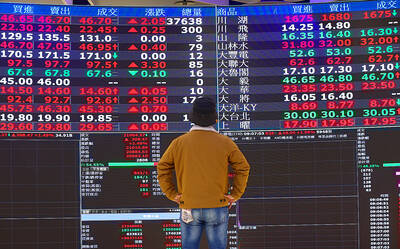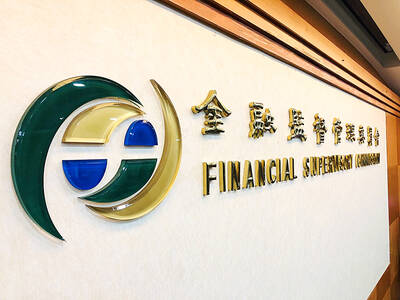The US Federal Reserve on Wednesday voted to hold interest rates at a 22-year high for a second straight meeting, as it moves to slow stubborn inflation without damaging the strong US economy.
The Fed’s decision to keep its benchmark lending rate between 5.25 percent and 5.5 percent gives policymakers time to “assess additional information and its implications for monetary policy,” the central bank said in a statement.
“The process of getting inflation sustainably down to 2 percent has a long way to go,” Fed Chair Jerome Powell said at a news conference, referring to the Fed’s long-term target for interest rates.

Photo: EPA-EFE
He added that the Fed “is not thinking about rate cuts right now, at all.”
The Fed’s widely expected decision to hold rates steady marks the first time officials have done so at two consecutive meetings since they began tightening monetary policy last year.
Since peaking at more than 7 percent in June last year, inflation as measured by the Fed’s favored yardstick has slowed by more than half — although it remains stuck firmly above 3 percent.
Many analysts, including those employed by the Fed, were predicting the US would enter a recession this year due to the rapid pace of interest rate hikes.
When the Fed hikes interest rates it raises the cost of borrowing from the bank, which normally dampens economic activity and weakens the labor market, but despite its aggressive monetary tightening, the Fed noted that “economic activity expanded at a strong pace in the third quarter.”
“Job gains have slowed in recent months, but remain strong, and the unemployment rate has remained low,” it said.
The Fed’s decision to pause would likely fuel expectations that it is done hiking interest rates and is moving instead to a prolonged pause.
“This is a Fed that wants to be done hiking rates,” economists at Citi wrote in an investor note after the decision was announced. “In our base case, the Fed will stay on hold and inflation will continue to run above target until a recession loosens the labor market and brings down inflation.”
Pantheon Macroeconomics chief economist Ian Shepherdson took a different view, saying that: “No decision on December has yet been taken,” and that the upcoming employment and inflation data would be key.
Despite the strong economic data, the Fed’s rate decision has been made easier by a surge in yields on longer-term US government bonds.
Whereas the Fed’s key short-term rate mainly affects the borrowing rates offered by banks, Treasury yields determine “everything from mortgage rates to corporate and municipal bond yields,” KPMG chief economist Diane Swonk wrote in a note to clients.
The Fed is “attentive to the increase in longer-term yields, which have contributed to a tightening of broader financial conditions since the summer,” Powell said.
EY chief economist Gregory Daco said that the Fed’s reference to tighter financial conditions in its interest rate announcement was “a nod to the fact that financial markets are doing some of the Fed’s tightening effort.”

The US dollar was trading at NT$29.7 at 10am today on the Taipei Foreign Exchange, as the New Taiwan dollar gained NT$1.364 from the previous close last week. The NT dollar continued to rise today, after surging 3.07 percent on Friday. After opening at NT$30.91, the NT dollar gained more than NT$1 in just 15 minutes, briefly passing the NT$30 mark. Before the US Department of the Treasury's semi-annual currency report came out, expectations that the NT dollar would keep rising were already building. The NT dollar on Friday closed at NT$31.064, up by NT$0.953 — a 3.07 percent single-day gain. Today,

‘SHORT TERM’: The local currency would likely remain strong in the near term, driven by anticipated US trade pressure, capital inflows and expectations of a US Fed rate cut The US dollar is expected to fall below NT$30 in the near term, as traders anticipate increased pressure from Washington for Taiwan to allow the New Taiwan dollar to appreciate, Cathay United Bank (國泰世華銀行) chief economist Lin Chi-chao (林啟超) said. Following a sharp drop in the greenback against the NT dollar on Friday, Lin told the Central News Agency that the local currency is likely to remain strong in the short term, driven in part by market psychology surrounding anticipated US policy pressure. On Friday, the US dollar fell NT$0.953, or 3.07 percent, closing at NT$31.064 — its lowest level since Jan.

The New Taiwan dollar and Taiwanese stocks surged on signs that trade tensions between the world’s top two economies might start easing and as US tech earnings boosted the outlook of the nation’s semiconductor exports. The NT dollar strengthened as much as 3.8 percent versus the US dollar to 30.815, the biggest intraday gain since January 2011, closing at NT$31.064. The benchmark TAIEX jumped 2.73 percent to outperform the region’s equity gauges. Outlook for global trade improved after China said it is assessing possible trade talks with the US, providing a boost for the nation’s currency and shares. As the NT dollar

The Financial Supervisory Commission (FSC) yesterday met with some of the nation’s largest insurance companies as a skyrocketing New Taiwan dollar piles pressure on their hundreds of billions of dollars in US bond investments. The commission has asked some life insurance firms, among the biggest Asian holders of US debt, to discuss how the rapidly strengthening NT dollar has impacted their operations, people familiar with the matter said. The meeting took place as the NT dollar jumped as much as 5 percent yesterday, its biggest intraday gain in more than three decades. The local currency surged as exporters rushed to